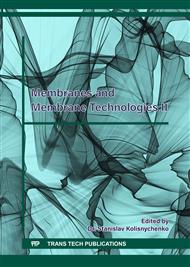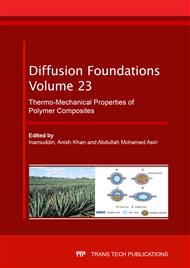[1]
E. Drioli, L. Giorno, Comprehensive membrane science and engineering, Newnes, (2010).
Google Scholar
[2]
K. Channabasappa, Membrane technology for water reuse application, Desalination 23(1-3) (1977) 495-514.
DOI: 10.1016/s0011-9164(00)82549-7
Google Scholar
[3]
R.E. Lacey, S. Loeb, Industrial processing with membranes, (1972).
Google Scholar
[4]
F. Kiil, Development of a parallel-flow artificial kidney in plastics, Acta Chir Scand Suppl 253 (1960) 142-50.
Google Scholar
[5]
A.S. Michaels, New separation technique for CPI, Chem. Eng. Prog. 64(12) (1968) 31.
Google Scholar
[6]
H.K. Lonsdale, The growth of membrane technology, J. Membr. Sci. 10 (1982) 81.
Google Scholar
[7]
H. Strathmann, L. Giorno, E. Drioli, An introduction to membrane science and technology, CNR publisher, Roma, (2006).
Google Scholar
[8]
H. Strathmann, Membrane separation processes, J. Membr. Sci. 9 (1981) 121-189.
Google Scholar
[9]
E. Drioli, C.A. Quist-Jensen, L. Giorno, Molecular Weight Cutoff, Encyclopedia of Membranes, Springer, 2015, pp.1-2.
DOI: 10.1007/978-3-642-40872-4_2216-1
Google Scholar
[10]
M. Cheryan, Ultrafiltration and microfiltration handbook, CRC press, (1998).
Google Scholar
[11]
X. Li, J. Li, Fluxes and Driving Forces in Membrane Separation Processes, Encyclopedia of Membranes, Springer2015, pp.1-3.
Google Scholar
[12]
H. Strathmann, Membrane separation processes: current relevance and future opportunities, AIChE Journal 47 (2001) 1077-1087.
DOI: 10.1002/aic.690470514
Google Scholar
[13]
J. Wijmans, A. Athayde, R. Daniels, J. Ly, H. Kamaruddin, I. Pinnau, The role of boundary layers in the removal of volatile organic compounds from water by pervaporation, J. Membr. Sci. 109 (1996) 135-146.
DOI: 10.1016/0376-7388(95)00194-8
Google Scholar
[14]
C. Yeom, S. Lee, H. Song, J. Lee, A characterization of concentration polarization in a boundary layer in the permeation of VOCs/N 2 mixtures through PDMS membrane, J. Membr. Sci. 205 (2002) 155-174.
DOI: 10.1016/s0376-7388(02)00075-3
Google Scholar
[15]
S. Zhao, Z. Li, Y. Liu, L.e. Wang, Simulation of binary gas separation in hollow fiber membrane-acetylene dehydration, Desalination 233 (2008) 310-318.
DOI: 10.1016/j.desal.2007.09.056
Google Scholar
[16]
R. Wang, S. Liu, T. Lin, T. Chung, Characterization of hollow fiber membranes in a permeator using binary gas mixtures, Chem. Eng. Sci. 57 (2002) 967-976.
DOI: 10.1016/s0009-2509(01)00435-3
Google Scholar
[17]
K. Haraya, T. Hakuta, H. Yoshitome, S. Kimura, A study of concentration polarization phenomenon on the surface of a gas separation membrane, Sep. Sci. Technol. 22 (1987) 1425-1438.
DOI: 10.1080/01496398708058408
Google Scholar
[18]
H. Takaba, S.-i. Nakao, Computational fluid dynamics study on concentration polarization in H 2/CO separation membranes, J. Membr. Sci. 249 (2005) 83-88.
DOI: 10.1016/j.memsci.2004.09.038
Google Scholar
[19]
J. Zhang, D. Liu, M. He, H. Xu, W. Li, Experimental and simulation studies on concentration polarization in H 2 enrichment by highly permeable and selective Pd membranes, J. Membr. Sci. 274 (2006) 83-91.
DOI: 10.1016/j.memsci.2005.07.047
Google Scholar
[20]
A. Caravella, G. Barbieri, E. Drioli, Concentration polarization analysis in self-supported Pd-based membranes, Sep. Purif. Technol. 66 (2009) 613-624.
DOI: 10.1016/j.seppur.2009.01.008
Google Scholar
[21]
A. Caravella, Concentration Polarization Coefficient (CPC), Encyclopedia of Membranes (2015) 1-3.
Google Scholar
[22]
P. Brian, Mass transport in reverse osmosis, Desalination by reverse osmosis, MIT Press, Cambridge, 1966, p.181.
Google Scholar
[23]
W.F. Blatt, A. Dravid, A.S. Michaels, L. Nelsen, Solute polarization and cake formation in membrane ultrafiltration: causes, consequences and control techniques, In: Flinn JE (ed), Plenum Press, New York, (1970).
DOI: 10.1007/978-1-4684-1851-4_4
Google Scholar
[24]
R. Bian, K. Yamamoto, Y. Watanabe, The effect of shear rate on controlling the concentration polarization and membrane fouling, Desalination 131 (2000) 225-236.
DOI: 10.1016/s0011-9164(00)90021-3
Google Scholar
[25]
E.M. Hoek, M. Elimelech, Cake-enhanced concentration polarization: a new fouling mechanism for salt-rejecting membranes, Environ. Sci. Technol. 37 (2003) 5581-5588.
DOI: 10.1021/es0262636
Google Scholar
[26]
E. Cornelissen, D. Harmsen, K. De Korte, C. Ruiken, J.-J. Qin, H. Oo, L. Wessels, Membrane fouling and process performance of forward osmosis membranes on activated sludge, J. Membr. Sci. 319 (2008) 158-168.
DOI: 10.1016/j.memsci.2008.03.048
Google Scholar
[27]
G. Pearce, Introduction to membranes: Fouling control, Filtr. Sep. 44 (2007) 30-32.
Google Scholar
[28]
R. Field, D. Wu, J. Howell, B. Gupta, Critical flux concept for microfiltration fouling, J. Membr. Sci. 100 (1995) 259-272.
DOI: 10.1016/0376-7388(94)00265-z
Google Scholar
[29]
P. Bacchin, A possible link between critical and limiting flux for colloidal systems: consideration of critical deposit formation along a membrane, J. Membr. Sci. 228 (2004) 237-241.
DOI: 10.1016/j.memsci.2003.10.012
Google Scholar
[30]
A.J. Bromley, R.G. Holdich, I.W. Cumming, Particulate fouling of surface microfilters with slotted and circular pore geometry, J. Membr. Sci. 196 (2002) 27-37.
DOI: 10.1016/s0376-7388(01)00573-7
Google Scholar
[31]
V. Chen, Performance of partially permeable microfiltration membranes under low fouling conditions, J. Membr. Sci. 147 (1998) 265-278.
DOI: 10.1016/s0376-7388(98)00141-0
Google Scholar
[32]
G. Belfort, R.H. Davis, A.L. Zydney, The behavior of suspensions and macromolecular solutions in crossflow microfiltration, J. Membr. Sci. 96 (1994) 1-58.
DOI: 10.1016/0376-7388(94)00119-7
Google Scholar
[33]
I.H. Huisman, E. Vellenga, G. Trägårdh, C. Trägårdh, The influence of the membrane zeta potential on the critical flux for crossflow microfiltration of particle suspensions, J. Membr. Sci. 156 (1999) 153-158.
DOI: 10.1016/s0376-7388(98)00328-7
Google Scholar
[34]
S. Ognier, C. Wisniewski, A. Grasmick, Membrane bioreactor fouling in sub-critical filtration conditions: a local critical flux concept, J. Membr. Sci. 229 (2004) 171-177.
DOI: 10.1016/j.memsci.2003.10.026
Google Scholar
[35]
P. Buch, D.J. Mohan, A. Reddy, Preparation, characterization and chlorine stability of aromatic–cycloaliphatic polyamide thin film composite membranes, J. Membr. Sci. 309 (2008) 36-44.
DOI: 10.1016/j.memsci.2007.10.004
Google Scholar
[36]
H. Strathmann, Economical evaluation of the membrane technology, Elsevier, London, (1989).
Google Scholar
[37]
W. Lau, A. Ismail, N. Misdan, M. Kassim, A recent progress in thin film composite membrane: a review, Desalination 287 (2012) 190-199.
DOI: 10.1016/j.desal.2011.04.004
Google Scholar
[38]
M. Mulder, Basic Principles of Membrane Technology, Springer Science & Business Media,(1996).
Google Scholar
[39]
A. Rahimpour, S. Madaeni, S. Zereshki, Y. Mansourpanah, Preparation and characterization of modified nano-porous PVDF membrane with high antifouling property using UV photo-grafting, Appl. Surf. Sci. 255 (2009) 7455-7461.
DOI: 10.1016/j.apsusc.2009.04.021
Google Scholar
[40]
S. Madaeni, A. Rahimpour, Effect of type of solvent and non‐solvents on morphology and performance of polysulfone and polyethersulfone ultrafiltration membranes for milk concentration, Polym. Adv. Technol. 16 (2005) 717-724.
DOI: 10.1002/pat.647
Google Scholar
[41]
R. Boom, I. Wienk, T. Van den Boomgaard, C. Smolders, Microstructures in phase inversion membranes. Part 2. The role of a polymeric additive, J. Membr. Sci. 73 (1992) 277-292.
DOI: 10.1016/0376-7388(92)80135-7
Google Scholar
[42]
A. Basile, F. Gallucci, Membranes for membrane reactors: preparation, optimization and selection, John Wiley & Sons,(2010).
Google Scholar
[43]
A. Rahimpour, S.S. Madaeni, Y. Mansourpanah, Fabrication of polyethersulfone (PES) membranes with nano-porous surface using potassium perchlorate (KClO 4) as an additive in the casting solution, Desalination 258 (2010) 79-86.
DOI: 10.1016/j.desal.2010.03.042
Google Scholar
[44]
Y.-L. Su, W. Cheng, C. Li, Z. Jiang, Preparation of antifouling ultrafiltration membranes with poly (ethylene glycol)-graft-polyacrylonitrile copolymers, J. Membr. Sci. 329 (2009) 246-252.
DOI: 10.1016/j.memsci.2009.01.002
Google Scholar
[45]
R.B. Bird, W.E. Stewart, E.N. Lightfoot, Transport Phenomena John Wiley & Sons, New York, (1960).
Google Scholar
[46]
C.J. Geankoplis, Transport processes and separation process principles:(includes unit operations), Prentice Hall, New Jersey, (2003).
Google Scholar
[47]
H.K. Lonsdale, The growth of membrane and technology, J. Membr. Sci. 10 (1982) 81-181.
Google Scholar
[48]
E.E. Meuleman, B. Bosch, M.H. Mulder, H. Strathmann, Modeling of liquid/liquid separation by pervaporation: toluene from water, AIChE journal 45 (1999) 2153-2160.
DOI: 10.1002/aic.690451014
Google Scholar
[49]
K.W. Lawson, D.R. Lloyd, Membrane distillation: review, J. Membr. Sci. 124 (1997) 1-25.
Google Scholar
[50]
K.S. Pitzer, L. Brewer, Thermodynamics (revision of Lewis and Randall), 2nd ed., McGraw-Hill, New York, (1961).
Google Scholar
[51]
A. Katchalsky, P.F. Curran, Nonequilibrium thermodynamics in biophysics, Harvard University Press, Cambridge, (1967).
Google Scholar
[52]
L. Onsager, Reciprocal relations in irreversible processes. II, Phys. Rev. 38 (1931) 2265.
DOI: 10.1103/physrev.38.2265
Google Scholar
[53]
O. Kedem, A. Katchalsky, Thermodynamic analysis of the permeability of biological membranes to non-electrolytes, Biochem. Biophys. Acta 27 (1958) 229-246.
DOI: 10.1016/0006-3002(58)90330-5
Google Scholar
[54]
M. Soltanieh, W.N. GILL', Review of reverse osmosis membranes and transport models, Chem. Eng. Commun. 12 (1981) 279-363.
DOI: 10.1080/00986448108910843
Google Scholar
[55]
T.-S. Chung, L.Y. Jiang, Y. Li, S. Kulprathipanja, Mixed matrix membranes (MMMs) comprising organic polymers with dispersed inorganic fillers for gas separation, Prog. Polym. Sci. 32 (2007) 483-507.
DOI: 10.1016/j.progpolymsci.2007.01.008
Google Scholar
[56]
N.H.H.A. Bakar, W.L. Tan, Natural composite membranes for water remediation: Toward a sustainable tomorrow, Renewable Energy and Sustainable Technologies for Building and Environmental Applications, Springer 2016, pp.25-49.
DOI: 10.1007/978-3-319-31840-0_2
Google Scholar
[57]
B. Thaci, S. Gashi, N. Daci, M. Daci, A. Dylhasi, Effect of modified coal through chemical activation process on performance of heterogeneous reverse osmosis membranes, Environ. Protect. Eng. 41 (2015) 53-65.
DOI: 10.37190/epe150105
Google Scholar
[58]
A. Zirehpour, A. Rahimpour, F. Seyedpour, M. Jahanshahi, Developing new CTA/CA-based membrane containing hydrophilic nanoparticles to enhance the forward osmosis desalination, Desalination 371 (2015) 46-57.
DOI: 10.1016/j.desal.2015.05.026
Google Scholar
[59]
S.A. Kiran, G. Arthanareeswaran, Y.L. Thuyavan, A. Ismail, Influence of bentonite in polymer membranes for effective treatment of car wash effluent to protect the ecosystem, Ecotoxicol. Environ. Saf. 121 (2015) 186-192.
DOI: 10.1016/j.ecoenv.2015.04.001
Google Scholar
[60]
N. Ghaemi, S.S. Madaeni, A. Alizadeh, P. Daraei, V. Vatanpour, M. Falsafi, Fabrication of cellulose acetate/sodium dodecyl sulfate nanofiltration membrane: characterization and performance in rejection of pesticides, Desalination 290 (2012) 99-106.
DOI: 10.1016/j.desal.2012.01.013
Google Scholar
[61]
S. Velu, K. Rambabu, I. Muruganandam, Preparation, characterization and application of cellulose acetate-iron nanoparticles blend ultrafiltration membranes, J. Chem. Pharm. Res. 5 (2013) 1418-1428.
Google Scholar
[62]
L.N. El-Din, A. El-Gendi, N. Ismail, K. Abed, A.I. Ahmed, Evaluation of cellulose acetate membrane with carbon nanotubes additives, J. Ind. Eng. Chem. 26 (2015) 259-264.
DOI: 10.1016/j.jiec.2014.11.037
Google Scholar
[63]
A. Ahmad, S. Waheed, S.M. Khan, M. Shafiq, M. Farooq, K. Sanaullah, T. Jamil, Effect of silica on the properties of cellulose acetate/polyethylene glycol membranes for reverse osmosis, Desalination 355 (2015) 1-10.
DOI: 10.1016/j.desal.2014.10.004
Google Scholar
[64]
G.R. Daisley, M.G. Dastgir, F.C. Ferreira, L.G. Peeva, A.G. Livingston, Application of thin film composite membranes to the membrane aromatic recovery system, J. Membr. Sci. 268 (2006) 20-36.
DOI: 10.1016/j.memsci.2005.05.024
Google Scholar
[65]
P. Wang, T.-S. Chung, Recent advances in membrane distillation processes: Membrane development, configuration design and application exploring, J. Membr. Sci. 474 (2015) 39-56.
DOI: 10.1016/j.memsci.2014.09.016
Google Scholar
[66]
S. Bonyadi, T.S. Chung, Flux enhancement in membrane distillation by fabrication of dual layer hydrophilic–hydrophobic hollow fiber membranes, J. Membr. Sci. 306 (2007) 134-146.
DOI: 10.1016/j.memsci.2007.08.034
Google Scholar
[67]
N.L. Le, S.P. Nunes, Materials and membrane technologies for water and energy sustainability, Sustainable Materials and Technologies 7 (2016) 1-28.
DOI: 10.1016/j.susmat.2016.02.001
Google Scholar
[68]
C. Feng, K. Khulbe, T. Matsuura, R. Gopal, S. Kaur, S. Ramakrishna, M. Khayet, Production of drinking water from saline water by air-gap membrane distillation using polyvinylidene fluoride nanofiber membrane, J. Membr. Sci. 311 (2008) 1-6.
DOI: 10.1016/j.memsci.2007.12.026
Google Scholar
[69]
L. Dumée, K. Sears, J.r. Schü tz, N. Finn, M. Duke, S. Gray, Carbon nanotube based composite membranes for water desalination by membrane distillation, Desalin. Water. Treat. 17 (2010) 72-79.
DOI: 10.5004/dwt.2010.1701
Google Scholar
[70]
K. Pourzare, Y. Mansourpanah, S. Farhadi, Advanced nanocomposite membranes for fuel cell applications: a comprehensive review, Biofuel Research Journal 3 (2016) 496-513.
DOI: 10.18331/brj2016.3.4.4
Google Scholar



